Corsair Obsidian Series 800D ATX Chassis Review
Internal Impressions
With the door panel removed you can quickly figure out that Corsair went with all black internals, which is pretty slick and the new ‘must have’ feature if you ask us.
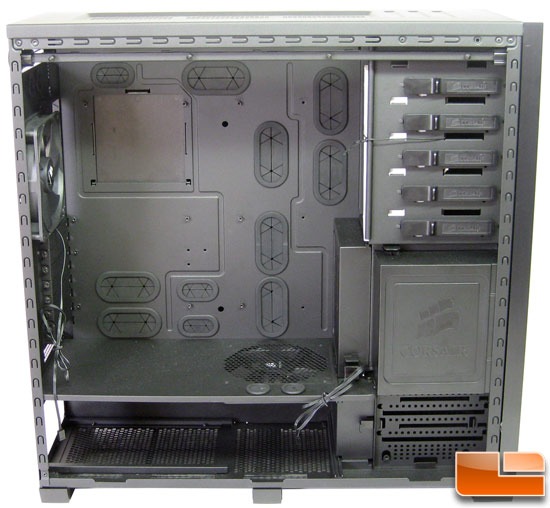
Corsair wanted to make routing wires easy for system builders of any skill level and provided an amazing number of grommet covered holes for wire routing. A couple of people that have seen this case in person said they might have gone a little crazy with the grommets, but can you ever have enough openings to run wires through? If you complain that cases aren’t built with cable management in mind then you better stop saying that as the Obsidian 800D has you covered. Also keep in mind that the grommets are designed to accommodate both mATX and ATX boards. In a case of this size, most people will be using an ATX board – which will cover up all of the mATX grommets and they will not been seen once a motherboard is installed.
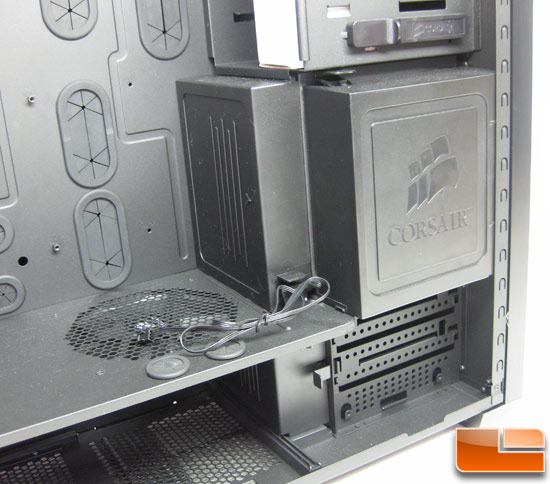
The plastic cover with the Corsair logo on it is covering a 140mm fan that blows air across the storage drives. The bottom of the plastic cover is open, so it brings in air from this ‘duct’ and blows it across the SSD’s or HDD’s. The hot air then is exhausted around the back side of the case and blown out the back panel. The rubber cable mounting grommets in the motherboard tray prevent much of the hot air from entering the main compartment, which is nice.
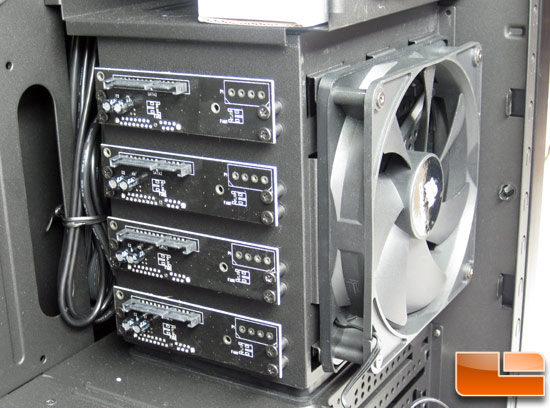
With the covers removed you can see the hot-swap SATA backplane that is being used in the Obsidian Series 800D chassis. The system uses four 3.5″ storage drive caddies, all of which also support 2.5″ hard disk drives and solid-state drives. Once attached to the drive caddies the drives can be slid in to the SATA connector backplane, which provides both data and power connections for each of the four drives.
The 140mm cooling fan on the side of the four drive SATA hot-swap bay ensures that the drives are kept nice and cool. If you are running Solid-State Drives (SSDs) this shouldn’t be a big concern, but to those running four Western Digital VelociRaptors in RAID 5 it is a major issue and good cooling is a must. Keeping your storage drives cool ensures they last as long as they possibly can.
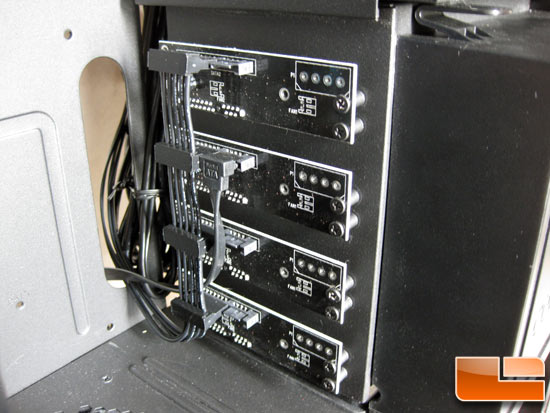
Corsair includes a special SATA power cable that was designed to fit each of the SATA headers just perfectly as you can see in the image above. They also include four SATA data cables that have a 90 degree elbow on one end to ensure that it can fit behind the plastic cover that makes the installation look clean. This is also nice as if you are planning on running a separate hardware RAID card you can plug the cards SATA connectors right into this backplane and be done with it. For those worried about the thickness (guage) of the supplied SATA power cable it should noted that they are 18 AWG and not some cheap thin ones.
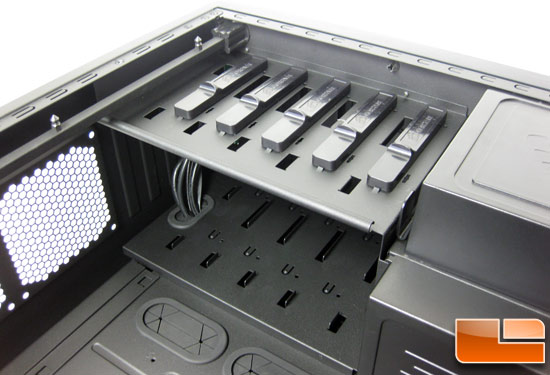
The five 5.25″ drive bays are easy to use, thanks to the tool-free installation system that is used on the Obsidian 800D. To use the drive rail system you just install the drive and slide the locking mechanism over when the holes line up. We also noticed that the wires for the front panel have been run through to the back of the chassis through a grommet covered opening that was installed just for this purpose.
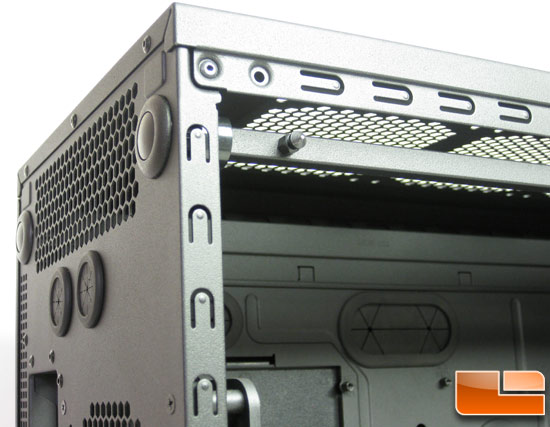
The single push button door rail system makes removing case doors easy as can be and getting them back on is just as easy. To remove a door panel on the Corsair Obsidian Series 800D chassis you need to just press the button and the door will pop open and you can then just lift it off. In order to close the door you must align three little notches along the bottom of the door with the chassis and then push the door closed.
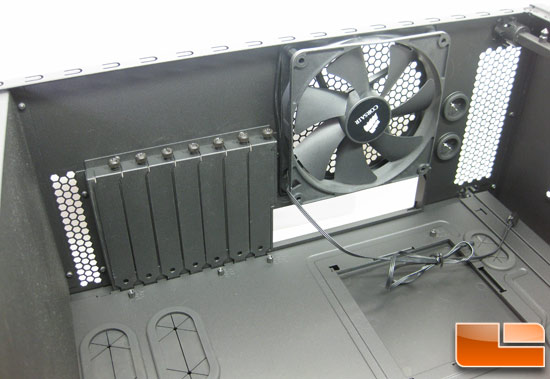
The Corsair Obsidian 800D is an enthusiast/gamer chassis, so there is plenty of room for a dual slot graphics card to go into the 7th expansion slot and hang off the bottom of the expansion slots frame. Corsair even put some ventilation holes there, which is a nice touch as some video cards could use that to exhaust hot air. Many popular overclocking and gaming oriented motherboards like the EVGA X58 3X SLI Classified and Gigabyte GA-EX58-EXTREME require a case like this, so this is an important design feature that needs to be pointed out if you want to run a multi-GPU video card setup down the road.
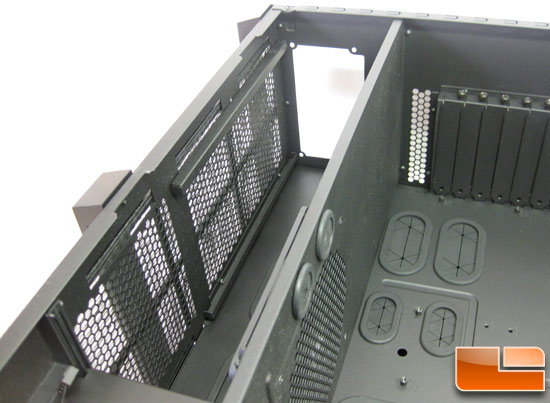
This picture shows off the sectioned off power supply cooling zone and you can see how the power supply rests on the little black metal rails and above the air filter. Just below the two pre-cut holes for routing tubing for a water cooler is a 140mm air fan that is the main air intake for the motherboard chamber.
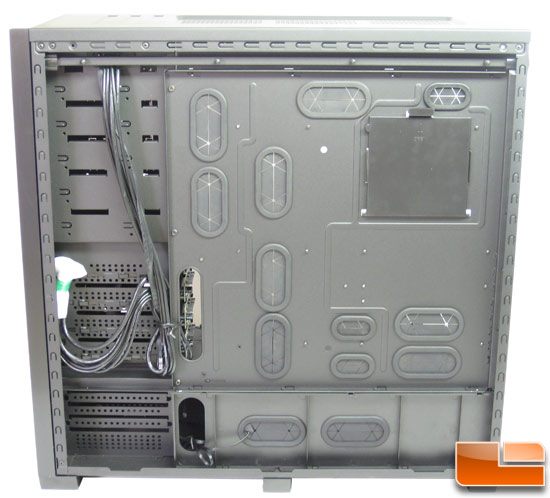
Here is a picture of the back of the system with the rear door panel removed. The case is set in just enough to hide some cabled and connections back here and Corsair even supplies a few zip ties with their bundle for just such a thing. The two lower grommets are for the power supply cables and when using long power supplies like the Corsair HX1000W the one closest to the rear of the case it nearly all the way blocked. It takes a little work getting all the cables through one grommet, but it was possible even with a triple-SLI video card setup that requires three 8-pin PCIe connectors and three 6-pin PCIe connectors. Speaking of which, let’s take a look at how assembly went.

Comments are closed.